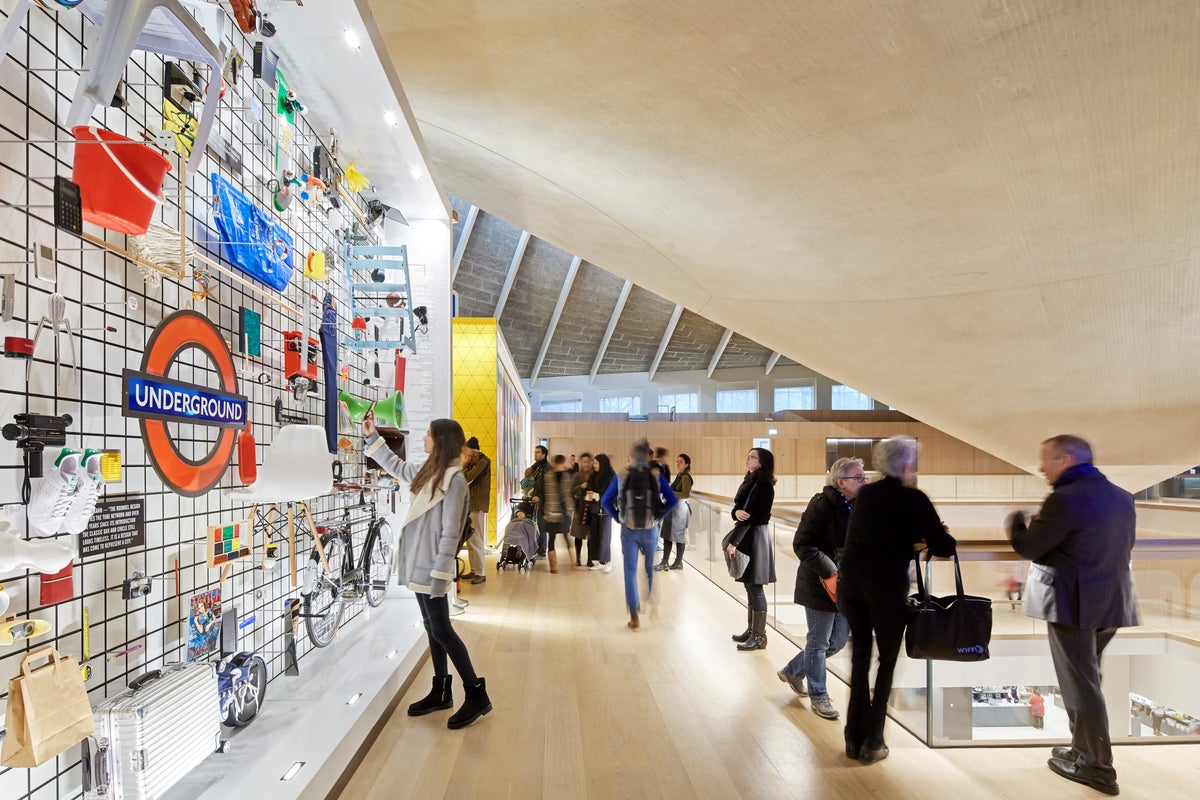‘The Teachings Are Alive in Us’
Reflections on Plum Village’s twentieth anniversary BIPOC retreat The post ‘The Teachings Are Alive in Us’ appeared first on Tricycle: The Buddhist Review.

I walked slowly, mindfully and sat at the front of the altar at the main meditation hall at Deer Park Monastery in Escondido, California. As I looked out onto the faces of hundreds of Black, Indigenous, and People of Color (BIPOC) attending the twentieth anniversary of the first BIPOC retreat at the monastery, a flash of memories came rushing back from the March 2004 Color of Compassion gathering, the first BIPOC retreat offered by Zen master Thich Nhat Hanh and Plum Village.
Back then, in 2004, I arrived at the retreat relatively new to Buddhism. Though I had been ordained in the Order of Interbeing in August 2003 at Stonehill College, I still felt inexperienced. I arrived a day early, flying into San Diego. Smog hung low over the city as though covered in cheesecloth. I got off the airport shuttle in downtown San Diego and headed to my $45.00-a-night room across from a strip mall and fast-food Chinese restaurant. That night, I fell asleep to a public television pledge-a-thon, offering a boxed-set collection of Peter, Paul, and Mary’s greatest hits. I awoke the next day to the smell of diesel idling and the voices of early- morning laborers. Going about my morning routine of yoga and meditation, I remember feeling grateful for the unhurried pace that this day brought. Typically, I’d be out the door on my way to a long and stressful day working as a lawyer-lobbyist, putting out fires, but this day, I could be in leisure, in retreat mode. After eating breakfast and packing, my Haitian cab driver drove me up the winding dirt road of Melru Lane to the gates of Deer Park Monastery that welcomed me with the words You have arrived.
The 2004 Colors of Compassion Retreat at Deer Park Monastery brought together more than 300 people of Asian American, Pacific Islander, African American, Latin American, Native American, and Southwest Asia and North African descent, plus a few European American family members. Many were new to Buddhism; many were attending a retreat for the first time. Many identified as lesbian, gay, transgender, or bisexual. It was and remains the largest Buddhist retreat specifically for people of color in North American history. That first event was so inspirational that it led to Thich Nhat Hanh and Plum Village’s commitment to offering BIPOC retreats more regularly. It even spawned a movie, Colors of Compassion, and a book, Together We Are One: Honoring Our Diversity, Celebrating Our Connection.
The 2004 gathering was life-changing. I felt that Thay was speaking directly to me and to us as BIPOC—that he understood the complexity of our lived experience, as well as our individual and collective legacy, burdens, and benefits. At that time and perhaps still even today, I was one of very few Black members of the Order of Interbeing. Part of my feeling inexperienced in the practice of Buddhism was my awareness that very few people who attended Plum Village retreats looked like me. This isolation gave rise to a feeling that I didn’t belong. During the 2004 retreat, Thay addressed this theme of isolation and belonging directly—his talks focused on how to cultivate a sense of home and belonging that comes from a place deep inside, regardless of external circumstances. Drawing from his own experience of not being able to return safely to his homeland of Vietnam, he stated that his “true home” is not limited by geography; it is the present moment, a place without hatred.

Twenty years later, as I walked to the altar, now as a dharma teacher in the Plum Village tradition, to offer a dharma talk with Brother Phap Dung on the third day of this historic anniversary gathering, I felt the poignancy of this moment. Looking out onto a sea of faces in a kaleidoscope of colors, I thought of Thay’s legacy of engaged social action, his teachings on interbeing, and his urgent message of mindfulness, concentration, and insight. I thought back to the way that Thay approached that same altar twenty years back. At the 2004 retreat, I always arrived early for Thay’s dharma talks and sat in front, next to the door that he often entered. Thay would slide off his slippers and walk silently to the front of the altar. I recall the sense of joy and solidity, groundedness, and nonrushing in each of his footsteps. It was an important reminder, a bell of mindfulness drawing attention to my own hurried, anxious, and impatient life. Over the course of that retreat, through feeling Thay’s energy and engaging in slow walking meditation with Thay and the community, I became aware of just how much I was driven by a constant undercurrent of urgency and even panic. Slowly, with this growing awareness, I began to understand what was beneath this urgency and to extend acceptance for that part of myself until I was able to change.
This anniversary retreat, though historic, was in many ways very similar to other Plum Village retreats that I have attended over the years, not just in the United States but also at the Plum Village Monastery in Dordogne, France. Each day, as a community, we engaged in a uniquely Plum Village approach to the practice of mindfulness through sitting, walking, eating, resting, speaking, and listening—where all of the activities of daily life were guided by mindful awareness. This particular approach to mindfulness emphasizes stopping and pausing in daily life so that we can be fully present in each moment. Through pausing, we can learn to release tension in the body, embrace our experience, and cultivate happiness and joy.
With each step, each breath, we can transform our suffering.
To invite these pauses, all the clocks in Plum Village monasteries are set to invite the sound of a bell every fifteen minutes. On hearing the bells, we are invited to stop, pause, and breathe, returning to our breath and body. As the days of the retreat progressed, it was so inspiring to watch BIPOC folks engage the practice of mindfulness with great sincerity and actually enjoy stopping, pausing, breathing, and remembering their own unique humanity. As BIPOC, many of us feel that we are short on time because we have to keep pushing and proving ourselves to the larger, dominant society. Many of us live with a daily sense that the world is unsafe and that we are not seen, heard, or understood for simply being who we are—we have to earn it. Sometimes we may feel that our worth is closely tied to what we do and how well we do it, which makes it feel like there is no time to slow down and just be.
This was brought home to me many years ago when I was leading a BIPOC retreat in a log cabin on the Grand River in Michigan. After I introduced the practice of mindful eating, a Black woman in our group said, “That’s the first time I’ve been gentle with my food. I eat in a rush; there’s no time.” Over the years, I have heard similar comments from many BIPOC about feeling on guard, anxious, and constantly second-guessing themselves. These simple mindfulness practices of sitting, walking, eating, breathing, resting, speaking, and listening help to restore our very humanity. With each step, each breath, we can transform our suffering.

On the first day of the retreat and orientation, we focused on settling into a feeling of arriving home with Sister Dang Nghiem and Brother Man Tue. The next day, Sister Than Nghiem and dharma teacher Diane Little Eagle guided us in an ancestral ceremony, where each retreatant was invited to bring an object from home that symbolized their ancestry and heritage and to place it on the altar. Later that day, two participants in the 2004 gathering, Sister An Nghiem and Brett Cook, shared their recollections of that event and the impact it had on each of their life journeys. Later that day, a panel of participants discussed the Five Mindfulness Trainings, skillfully facilitated by Sister Than Nghiem.
Mindful walking is a core practice of meditation in the Plum Village tradition and was an important teaching for Thay, so on the third day of the retreat, many participants hiked to the top of a nearby mountain for mindful breakfast at sunrise in true Plum Village style. In our joint dharma talk that morning, Brother Phap Dung and I focused on the Plum Village practice of beginning anew, a practice of reconciliation and maintaining healthy relationships. After the talk, a young Palestinian participant expressed their concerns about the war in Palestine and Gaza, and the exchange ended in a tearful moment when Brother Phap Dung offered the participant the practice of hugging meditation. That evening Sister Phu Nghiem facilitated a panel on loving ourselves.
On the fourth day, which was called “Healing Self and the Collective,” we had a beautiful ceremony on the Five Earth Touchings to Our Ancestors offered by Sister Kinh Nghiem, where we were invited to reflect on the lived experiences of our spiritual and blood ancestors, as well as the suffering and joy of our collective ancestors. We then practiced touching the earth in prostration to the Buddha, allowing the Earth to accept and heal us. In the evening, we held a celebratory Be-In that included a variety of presentations on the practice of mindfulness, and one presentation in particular presented a revised version of the Earth Touchings that honored SWANA (Southwest Asia and North Africa) ancestry.
The final day concluded with an inspiring closing talk by Sister Boi Nghiem and dharma teacher Juliet Hwang, as well as the joyful transmission of the Five Mindfulness Trainings to almost half the participants as an expression of Buddhist spirituality and ethics. As I looked at the BIPOC practitioners receiving the Five Mindfulness Trainings, I felt gratitude for my own twenty years of practice, as well as hope for the future of the sangha. Thay often said that one Buddha is not enough: We need many buddhas. We can all be buddhas through our listening, speaking, eating, and walking. Through our thoughts, speech, and actions, we can be an instrument of peace. In this way, Thay’s legacy, like a cloud, never dies—it lives on through each generation of BIPOC practitioners. Whether I am able to attend the fortieth anniversary of the first BIPOC retreat is uncertain, but I do know this for sure: The teachings are alive in us.
Through our thoughts, speech, and actions, we can be an instrument of peace. In this way, Thay’s legacy, like a cloud, never dies—it lives on through each generation of BIPOC practitioners.
Twenty years later, Plum Village continues Thay’s legacy and commitment to the BIPOC community. While there is surely a need for a more robust understanding of issues of diversity, equity, inclusion, and belonging within the tradition going forward, at least for five days this retreat offered hundreds of BIPOC participants an opportunity to savor the peace, calm, and self-love given by the dharma.

 Kass
Kass 

























![Are You Still Optimizing for Rankings? AI Search May Not Care. [Webinar] via @sejournal, @hethr_campbell](https://www.searchenginejournal.com/wp-content/uploads/2025/06/1-1-307.png)





